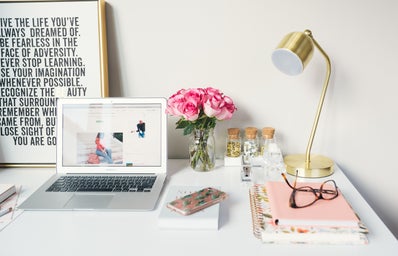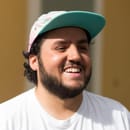With the internet being so easy to access, it has become easier for independent artists to find an audience and let their work be known. As a result, a variety of movements, collectives, and scenes have found a way to pave their path. The independent art scene in Puerto Rico is no different. Recently, many artists from a variety of disciplines have found platforms that have made it easier for them to share their work. In addition, small businesses such as Electroshock in Santurce and Rio Piedras, bars like Off The Wall in Mayaguez, and libraries like La Casita Books and Gifts in Aguadilla have provided up-and-coming artists a space to display their talents. “Puerto Rican Women Killing It in the Independent Art Scene” is a series of interviews that provides a glimpse at some of the women who have recently gained recognition in the art scene. Though the artists are asked similar questions, some are asked questions surrounding their work, specifically.
Bajo La Luna is a group of musicians who combine music with poetry and dance. Iliana Vázquez works on music composition, singing in a variety of genres, dancing and playing a few instruments. Alexandra Muñiz composes, sings, dances, and is also the visual artist of the group. Elisaura Vázquez is a poet who also plays the bomba drum. In addition, musicians Miguel Duprey and Gilberto Nieves help in percussion and other instruments.
How did you develop your style, and how has it evolved through the years?
We all came together already having experience in the artistic mediums we work in. What we did was combine these mediums without any restriction and fused them with musical styles like nova trova and flamenco, as well as a variety of percussion instruments and others that caught our eye. This has allowed us to challenge ourselves, especially the way we sing and recite poetry, making it a fun process. Fusing these rhythms has also allowed us to connect with audiences who weren’t really into them, especially poetry; it is beautiful to have that exchange with the audience. The people also provide ideas that motivate us to stretch our possibilities. One of group’s strengths is that, throughout the years, we have found our capabilities, and we push each other out of our comfort zone, which has kept us enthused for over three years.
What do you think about the current state of the arts in Puerto Rico?
It is in a wonderful state. We can find what isn’t regularly found in first world countries in every corner. There’s a lot of live music, whether it is in a bar, a restaurant, the beach, a local plaza, or the theatre. There has also been a rise in poetry nights, murals on the streets, and artisans are slowly occupying local plazas. In addition, art is being used for mental health therapy, protests, and processes of resistance. Artists are also educating themselves and defending their rights. Our people want and need to manifest themselves. They have the talent, and they will express themselves with their souls. The government’s agenda under a colonial and imperialist vision is the biggest obstacle for a country with flavor, sounds, and bright colors, so the art made here will reflect that and what we do in order to move and develop as a country.
(Bajo La Luna performing in the Rincon Art Walk)
What do you think about the current state of the independent scene in Puerto Rico?
The independent scene is the only way to maintain the genuine expression of Puerto Rican artists at the moment. All of the doors have become funnels. Outside the country, we have the representation presented by the big music companies. The same applies for the other artistic mediums. Puerto Rico will be what the people want. The artist needs resources–instruments, transportation, time and practice–in order to work. A justifiable pay for the artists and artisans is key in the survival of the independent art and music scene. The rest of the music is generic and mass production brought forth by capitalists.
Is there any other form of art you wish to pursue? If so, what field and why?
Bajo la Luna has a bit of everything: artisans, plastic artists, writers, photographers, graphic artists, a gallery curator, composers, singers, dancers. We want to bring everything we are to the group, aiding and educating each other at the same time.
(Bajo La Luna in the celebration of La Liga de la Leche’s 60th Anniversary)
If a young girl came up to you and said she wanted to be an artist, what would be your advice for her?
Whoever feels the call to become an artist and has the talent should answer that call. We will always support the development of an artist. Our biggest piece of advice for that person would be to get educated in anything that might help their intellectual growth so they can have another form of income and the quality of life they want. All of the members of Bajo la Luna have paying jobs. If the conditions would open doors so we could work exclusively as artists, we would take the opportunity, as long as we wouldn’t to worry about our income.
What do you seek to achieve with your work?
We seek to unite the people. We want them to have a space where they can find themselves, get inspired, have fun, and forget about their problems. In our lyrics we put our humanity, love, and respect for our people and our land. We invite audiences to reflect about our right to live with dignity, our right to feel, and our job to take care of each other and nature. We also touch on spirituality, romantic love, and our country’s history. We in Bajo la Luna are very aware of the privilege of using a stage and microphone as well as the responsibility this power entails.
(promo for Bajo La Luna’s first concert)
What is your biggest goal right now?
Our biggest goal is to travel across the world with our music and poetry while also enjoying the process. We also wish to share who we are. In addition, we want our lives to be filled with social justice, tropical fruits, fresh vegetables, music, and poetry. We want to feel the heat that comes out of a bomba drum and the laughter that comes after making an error on stage. We want to see the spark in our people’s eyes, hear an applause and a “thank you” at the end.
All of the pictures in this article were found in the Bajo La Luna’s Facebook page


